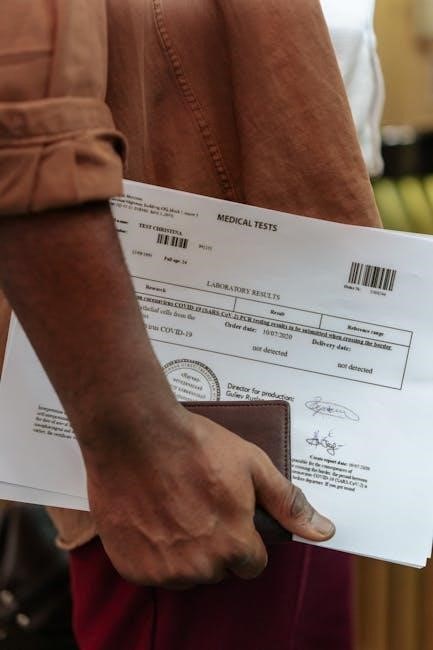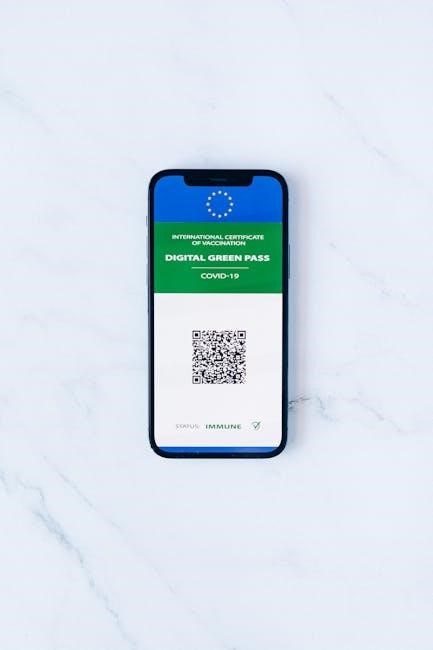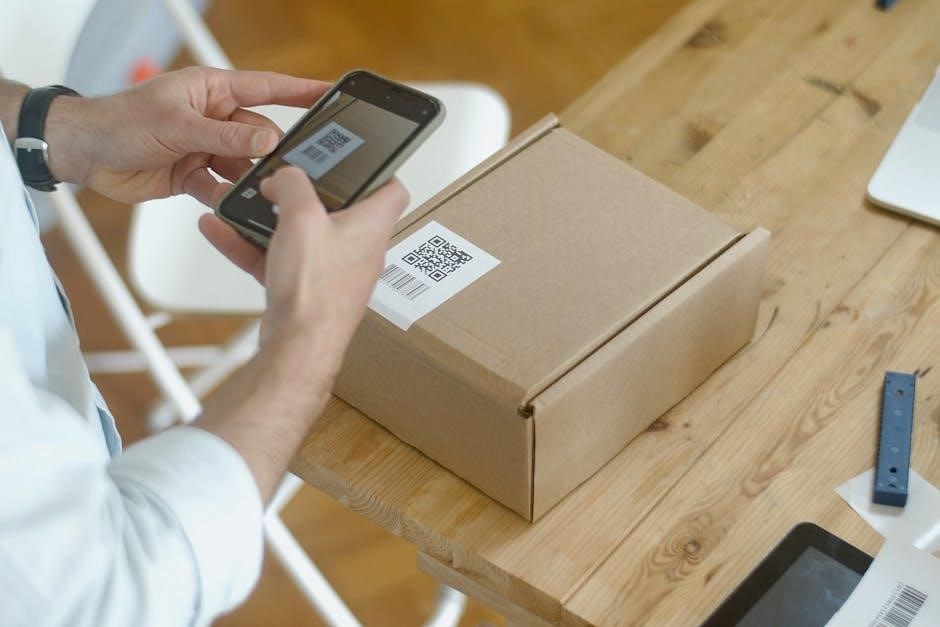A Micro PDF Barcode is a compact 2D barcode designed for encoding moderate data efficiently in limited spaces, ideal for applications requiring high data capacity and reliability. It’s widely used in official documents and medical devices for secure data storage.
1.1 Overview of Micro PDF Barcode
The Micro PDF Barcode is a compact, two-dimensional barcode symbology derived from PDF417, designed to store data efficiently in a small space; It is a multi-row stacked barcode that supports structured append, enabling data splitting across multiple symbols. This feature makes it ideal for applications requiring moderate data storage, such as EU driver’s licenses and FDA-regulated medical devices. Micro PDF Barcode is known for its high data capacity relative to its size, making it a reliable choice for secure and space-constrained environments. Its versatility ensures it meets diverse data encoding needs across various industries.
1.2 Importance of Compact Data Encoding
Compact data encoding is crucial for applications where space is limited but data integrity must be maintained. Micro PDF Barcode excels in this regard, enabling efficient storage of information in a small footprint. Its ability to encode data densely ensures that critical details, such as identification numbers or medical information, remain accessible without requiring large label areas. This compactness is vital for official documents like EU driver’s licenses and medical devices, where space constraints are significant. By minimizing label size while preserving data capacity, Micro PDF Barcode enhances both practicality and security, making it a reliable choice for sensitive and space-constrained environments.

History and Development of Micro PDF Barcode
Developed in 1996 by Frederick Schuessler, Kevin Hunter, Sundeep Kumar, and Cary Chu, Micro PDF417 evolved from PDF417. Standardized in 2006, it gained adoption as a compact, efficient 2D barcode solution.
2.1 Patent and Inventors
The Micro PDF417 barcode was patented in 1996 by Frederick Schuessler, Kevin Hunter, Sundeep Kumar, and Cary Chu from Symbol Technologies. This invention marked a significant advancement in barcode technology, enabling the creation of a compact, high-capacity 2D symbology. The patent laid the foundation for its adoption across various industries, including government and healthcare. Their work built upon the existing PDF417 standard, introducing a scaled-down version that maintained robustness while reducing size, making it ideal for applications with space constraints.
2.2 Evolution from PDF417
Micro PDF417 is a compact version of the PDF417 barcode, designed to encode data efficiently in limited spaces while maintaining high reliability. It retains the core principles of PDF417 but optimizes size and data capacity for applications requiring smaller symbols. This evolution ensures compatibility with systems already using PDF417, offering a seamless transition to a more space-efficient solution. The structured append feature allows for splitting data across multiple symbols, enhancing flexibility. Micro PDF417 is widely used in official documents and medical devices, ensuring secure and reliable data storage. Its development reflects advancements in barcode technology aimed at meeting modern data encoding needs.

2.3 Standardization and Adoption
Micro PDF417 was standardized under ISO/IEC 24728:2006, ensuring global compatibility and adoption. Its compact design made it ideal for official documents like EU driver’s licenses and FDA-regulated medical devices. The standardization facilitated widespread use across industries, particularly where space efficiency and data integrity are critical. Structured append functionality further enhanced its versatility, enabling data splitting across multiple symbols. This standardization has driven its adoption in secure identification and traceability applications, solidifying its role in modern data management systems. Its reliability and efficiency continue to make it a preferred choice for organizations requiring robust barcode solutions.

Key Features of Micro PDF Barcode
Micro PDF Barcode combines compact data storage, multi-row symbology, and robust error correction, enabling efficient encoding in limited spaces while maintaining high data capacity and reliability.
3.1 Compact Data Storage
Micro PDF Barcode excels in compact data storage, enabling efficient encoding of moderate data in a minimal space. Its design ensures high data density without compromising readability, making it ideal for applications where space is limited. This feature is particularly beneficial for official documents, medical devices, and supply chain systems, where information must be stored securely and accessed quickly. The compact nature allows for seamless integration into various formats without sacrificing data integrity, ensuring reliability in diverse operational environments.
3.2 Multi-Row Symbology
Micro PDF Barcode employs multi-row symbology, arranging data in multiple rows to maximize space efficiency. This feature allows for the storage of a moderate amount of information in a compact format, ensuring readability and scan accuracy. The multi-row structure enhances data organization, making it easier for scanners to interpret the barcode. This symbology is particularly effective in applications where physical space is constrained, enabling seamless integration into small labels or documents. The multi-row design ensures that the barcode remains legible even in limited areas, maintaining its functionality across various environments and use cases.
3.3 Error Correction and Robustness
Micro PDF Barcode incorporates advanced error correction mechanisms to ensure data integrity and robustness. It uses Reed-Solomon error correction, which allows recovery of corrupted or damaged data. This feature enhances reliability, especially in challenging environments where barcodes may be subject to wear, scratches, or fading. The barcode’s robust structure minimizes the risk of data loss, ensuring accurate scanning even when portions of the symbol are compromised. This makes it highly suitable for secure applications, such as official documents and medical devices, where data accuracy and reliability are critical. Its robustness also supports anti-counterfeiting measures, safeguarding against unauthorized alterations or reproductions.

Applications of Micro PDF Barcode
Micro PDF Barcodes are widely used in EU driver’s licenses, FDA-regulated medical devices, and supply chain management. They efficiently store and retrieve critical data in compact spaces, ensuring accuracy and reliability in various industries.

4.1 EU Driver’s Licenses
The Micro PDF Barcode is extensively used in EU driver’s licenses to encode essential information securely. This includes personal details, license categories, and security features. Its compact yet robust design ensures readability while minimizing space usage. The barcode’s structured append feature allows for efficient data management. This application highlights the barcode’s reliability in official documentation, making it a trusted solution for identity verification and legal compliance across European countries, ensuring seamless data retrieval by authorities and organizations.
4.2 FDA-Regulated Medical Devices
Micro PDF Barcodes are widely utilized in FDA-regulated medical devices to ensure secure and efficient data storage. They encode critical information such as model numbers, serial numbers, and expiration dates. The compact design of Micro PDF Barcodes makes them ideal for small medical devices, where space is limited. Their robust error correction and structured append features enhance data integrity, preventing counterfeiting and ensuring compliance with FDA regulations. This technology plays a crucial role in supply chain management and patient safety, enabling quick identification and traceability of medical devices.
4.3 Supply Chain and Inventory Management
Micro PDF Barcodes are invaluable in supply chain and inventory management for tracking and identifying products efficiently. Their compact size and high data capacity enable the storage of detailed product information, such as serial numbers, batch codes, and shipping details. This ensures accurate tracking and traceability throughout the supply chain. The barcode’s robust error correction and structured append features enhance reliability, even in challenging environments. Additionally, their compatibility with mobile scanning devices facilitates quick data collection in logistics and warehouse management, streamlining operations and reducing errors. This makes Micro PDF Barcodes a reliable solution for modern supply chain systems.
Technical Specifications of Micro PDF Barcode
Micro PDF Barcodes offer high data capacity, compact size, and structured append features, enabling efficient encoding of up to 150 bytes with robust error correction capabilities.
5.1 Data Capacity and Size
Micro PDF Barcodes offer a data capacity of 25 to 150 bytes, making them suitable for applications requiring moderate data storage in a compact format. The barcode’s size is optimized, with variable rows and columns (4-52 rows and 4-44 columns), ensuring efficient use of space. This structure allows for high-density encoding while maintaining readability. The compact size makes it ideal for small labels and official documents, such as EU driver’s licenses and medical devices, where space is limited but data integrity is crucial. Its scalability enables it to adapt to different data requirements while preserving its robust error correction capabilities.
5.2 Structured Append Feature
The Structured Append feature in Micro PDF Barcodes allows for efficient data splitting across multiple symbols, enabling the encoding of larger datasets. This feature is particularly useful when the data exceeds the capacity of a single barcode. By structuring data into appendable units, it ensures seamless reconstruction of the original information during decoding. This capability enhances flexibility, especially in applications like supply chain management and medical devices, where comprehensive data tracking is essential. The feature maintains data integrity and simplifies the process of managing extensive information, making it a valuable tool for complex data storage needs.
5.3 Encoding Process
The Micro PDF Barcode encoding process involves converting input data into a compact 2D symbol. Data preparation begins with text encoding, followed by error correction. The data is then structured into a grid of rows and columns, forming the barcode pattern. Each symbol is optimized for space efficiency, ensuring minimal size without sacrificing data integrity. The process supports various encoding modes, including text, binary, and numeric, making it versatile for different applications. The final step involves generating the visual barcode, ready for printing or digital use, ensuring reliability in scanning and data retrieval.

Security and Authentication
The Micro PDF Barcode incorporates robust security features, including anti-counterfeiting measures and advanced data encryption, ensuring authenticity and integrity in sensitive applications.
6.1 Anti-Counterfeiting Measures
Micro PDF Barcodes employ advanced anti-counterfeiting techniques, such as unique encoding patterns and error correction, making replication difficult. These features ensure data integrity and authenticity, crucial for secure applications.
6.2 Data Integrity and Encryption
Micro PDF Barcodes ensure data integrity through advanced encoding and error correction, making them resistant to tampering. The structured append feature allows splitting data across multiple symbols, enhancing security. While the barcode itself doesn’t encrypt data, encryption can be applied before encoding, ensuring confidentiality. This combination of robust encoding and optional encryption makes Micro PDF Barcodes highly secure for sensitive applications like medical devices and official documents.

Generating Micro PDF Barcodes
Micro PDF Barcodes can be generated using online tools, programming libraries, or SDKs. These methods offer flexibility for creating compact, high-capacity barcodes tailored to specific needs and applications.
7.1 Online Barcode Generators
Online barcode generators provide a convenient and user-friendly way to create Micro PDF Barcodes. Tools like TEC-IT Barcode Generator and others offer free or subscription-based services, allowing users to input data and customize settings. These platforms support various formats, including bitmap and vector images, ensuring compatibility with different applications. Many generators are web-based, eliminating the need for software installation. They are ideal for individuals and businesses needing quick, high-quality barcode generation. Popular options include the MicroPDF417 Generator and TEC-IT Barcode Generator, which cater to both non-commercial and private use, making them accessible for a wide range of users.
7.2 Programming Libraries and SDKs
Programming libraries and SDKs enable developers to integrate Micro PDF Barcode generation into their applications. Tools like TEC-IT Barcode SDK and OnBarcode PDF417 SDK provide robust APIs for creating customized barcodes. These libraries support various programming languages, including C#, Java, and Python, making them versatile for different development environments. They offer features such as data encoding, error correction, and image customization. Additionally, some SDKs support structured append functionality, allowing multiple symbols to be linked. These tools are essential for businesses needing to automate barcode generation and ensure high-quality output for reliable scanning and data retrieval.
7.3 Best Practices for Generation
When generating Micro PDF barcodes, follow best practices to ensure readability and reliability. Use high-resolution images to maintain clarity, and select colors with sufficient contrast for scanners. Ensure data is accurately encoded and avoid overcrowding symbols. Implement error correction to enhance robustness. Validate barcodes using ISO/IEC standards and test them with multiple scanners. Use reliable tools like TEC-IT Barcode Generator or OnBarcode SDK for consistent output. Always preview and verify barcodes before finalizing. These practices ensure optimal performance and compliance with industry standards, critical for applications like EU driver’s licenses and medical devices.
Reading and Scanning Micro PDF Barcodes
Micro PDF barcodes are efficiently read using compatible 2D scanners and software tools, ensuring accurate data retrieval. High-resolution images and sufficient contrast enhance readability, while verified scanners guarantee reliability.
8.1 Compatible Scanners and Readers
Micro PDF barcodes are read using advanced 2D barcode scanners, such as the MicroHAWK ID-30 and ID-40, designed for high-speed decoding. These scanners feature high-resolution imaging and advanced algorithms to ensure accurate data retrieval. Additionally, readers from companies like TEC-IT and Dynamsoft support Micro PDF417 decoding, offering robust performance across various environments. Many modern handheld and stationary scanners are compatible with Micro PDF barcodes, making them accessible for both industrial and commercial use. These devices ensure reliable scanning, even in challenging conditions, supporting applications in healthcare, logistics, and government sectors.
8.2 Software Tools for Decoding
Various software tools are available for decoding Micro PDF barcodes, including libraries, SDKs, and online solutions. Dynamsoft Barcode Reader and TEC-IT Barcode Generator offer robust decoding capabilities, supporting multiple platforms. These tools enable efficient data extraction from Micro PDF417 barcodes, ensuring accuracy and reliability. Additionally, online barcode readers like the TEC-IT Barcode Generator provide free solutions for non-commercial use, while premium options offer advanced features for industrial applications. Many software tools are compatible with programming languages such as C++, Java, and Python, making integration seamless across various systems. These tools are essential for industries requiring high-speed, precise decoding of Micro PDF barcodes.
8.3 Mobile Apps for Data Collection
Mobile apps like Scan-IT to Office enable real-time data collection using Micro PDF barcodes. Compatible with Android and iOS, these apps send scanned data directly to Excel, Google Sheets, or databases. TEC-IT’s solutions also support remote scanning, enhancing field operations. Apps like these are widely used in healthcare and inventory management for efficient data capture. They often integrate with cloud services, ensuring seamless data synchronization. Free versions are available for non-commercial use, while premium options offer advanced features. These mobile tools simplify data collection, making Micro PDF barcode scanning accessible on the go.

Comparisons with Other Barcode Types
Micro PDF417 excels in compact data storage compared to QR Codes and Data Matrix. It offers structured append features, making it ideal for official documents and medical devices, unlike traditional PDF417.
9.1 Micro PDF417 vs. QR Code
Micro PDF417 and QR Codes are both popular 2D barcodes, but they differ in functionality. QR Codes are widely used for general purposes, offering high error correction and flexibility in various applications like marketing and consumer engagement. Micro PDF417, however, is optimized for compact data storage, making it ideal for official documents and medical devices where space is limited. While QR Codes support more data types, Micro PDF417 excels in structured data encoding, ensuring robustness and security. The choice depends on the application, with Micro PDF417 being preferred for specialized, data-dense scenarios.
9.2 Micro PDF417 vs. Data Matrix
Micro PDF417 and Data Matrix are both 2D barcodes, but they cater to different needs. Data Matrix is renowned for its small footprint and high data capacity, making it ideal for electronics and healthcare. Micro PDF417, while also compact, offers structured append functionality for splitting data across multiple symbols. Data Matrix excels in tiny spaces like semiconductor marking, whereas Micro PDF417 is better suited for official documents and medical devices requiring moderate data storage. Both ensure robust error correction, but their applications vary based on size constraints and data complexity.
9.3 Micro PDF417 vs. Traditional PDF417
Micro PDF417 is a compact version of the traditional PDF417 barcode, designed for smaller spaces while maintaining reliability. Unlike traditional PDF417, which offers higher data capacity and robustness, Micro PDF417 is optimized for applications requiring moderate data storage. It supports structured append, allowing data to be split across multiple symbols, which traditional PDF417 does not. While traditional PDF417 is ideal for complex applications with large data needs, Micro PDF417 excels in scenarios like official documents and medical devices, where size constraints are critical. Both ensure high data integrity but cater to different use cases based on size and capacity requirements.

Future Trends and Innovations
Advancements in data capacity and integration with emerging technologies like blockchain and AI promise enhanced security and efficiency for Micro PDF barcodes in future applications.
10;1 Advancements in Data Capacity
Advancements in data capacity for Micro PDF barcodes focus on enhancing storage efficiency without compromising size. Improved encoding algorithms and compression techniques enable higher data density, allowing more information to be stored in the same compact space. The structured append feature has been optimized to handle larger datasets seamlessly across multiple symbols. Additionally, advancements in error correction ensure data integrity even as capacity increases. These improvements make Micro PDF barcodes more versatile for applications requiring robust, space-efficient data storage solutions.
10.2 Integration with Emerging Technologies
Micro PDF barcodes are increasingly being integrated with emerging technologies like IoT, AR, and blockchain to enhance functionality. IoT enables real-time data monitoring, while AR overlays provide interactive experiences. Blockchain integration ensures secure, decentralized data sharing. Advances in encoding algorithms and 5G connectivity further improve processing speeds and reliability. These integrations expand Micro PDF barcodes’ applications in smart packaging, healthcare, and supply chain management, making them a versatile tool for modern data-driven systems. Such innovations ensure Micro PDF barcodes remain relevant in a rapidly evolving technological landscape.
